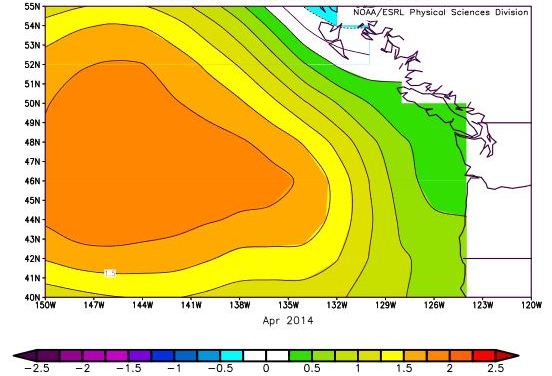 |
Heat image showing the extent of how large the Blob is and
the scale of how much warmer the waters are.
|
The Blob is a large patch of ocean water stemming in the Gulf of Alaska that has reached 2.5 degrees Celsius above normal.
These oceanic heat waves started in late 2013 and by 2015 had more than doubled its size to more than 4 million share kilometers. There was many difference forces acting together to form the Blob. It started "by a long-lasting atmospheric ridge of high pressure" which repressed the winter storms that would have helped to cool the atmosphere causing for the area to remain warmer than usual. In the following years, winds brought warm air from the south and El Niño, the periodic warming of the central Pacific. It was not until the end of 2016 that La Niña brought in storms that stirred up the
ocean breaking the curse of the heat wave.
When the Blob heat wave reached its extent and finally stopped warming, the damage on the
marine ecosystem was tragic. Marine Biologist Steve Barbeaux looked into the data along with the
National Oceanic and Atmospheric Administration (NOAA) in 2017 to see just how much damage was done by the Blob. Starting at the bottom with the smallest organisms, phytoplankton blooms declined due to the slow of nutrient cycling from there being a lack of winds. This caused for
copepods, small crustaceans that eat algae, to not grow as large as usual. Krill, a key food source for many fish, were also affected by the heat wave as "the heat-sensitive creatures vanished from biologists' nets." The bottom of the food chain becoming scarcer had effects on the rest of the chain.
The smaller fish that eat these small creatures were becoming more scarce due to the warm waters, the ones that remained were lacking in size and nourishment. An estimate done in 2015 assumed that the key fish in the gulf had fallen to below 50% of where it usually was. This ultimately effected the seabirds and their diet as most of it had disappeared and became more scarce. Animals were being found washed up on shorelines even large organisms such as whales. The whole food web was altered from this heat wave. Even after the heat subsided, the impact was still large. Less than 100 humpback whales had returned back to
Glacier Bay, with only one new calf with them compared to eight or more calved typically. Cod, a common fish to catch for market, numbers will still low leading to federal officials changing the limit of how many cod fisheries could catch by 80%.
Even though the Blob's heat subsided, it was important for scientists to observe and understand what was happening. This data could be what our future is going to look like due to global warming and rising ocean waters.



I have heard of "El Nino" before and how it has changed precipitation and other factors within the ocean but I had no idea how much it effected the marine life. It should come to no surprise how entire ecosystems can cascade due to the bottom-most tropic levels collapsing. I can only assume how the effects of "The Blob" will continue to impact our marine life. What do you expect to see in 10 years time?
ReplyDelete